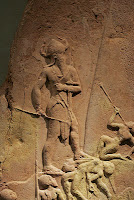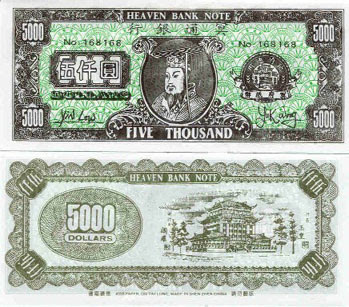Why is it called The Sanctuary?
I think I'm getting the picture now; the story goes something like this: At first there were mortuary enclosures (in this case Windmill Hill). The dead were left there until they were mostly bone, the skulls and long bones in particular were gathered up to be placed within the long barrows. As time went on the shape of the forecourts became more moon shaped (semi-lunar) and the long barrows more symbolic than functional. It was no longer necessary to put bones inside elaborate inner chambers, small side chambers would do.
Though how representative Belas Knap is of the genre I don't honestly know. I'm assuming that Belas Knap is younger than say West Kennet? Because Belas Knap's forecourt is bigger than that at West Kennet, and Belas Knap has side chambers on the outside of the barrow, rather than inside. The theory predicts that there should be a trend towards simplification and exaggeration of form to make the site increasingly symbolic.
I'm sticking with Wessex (only as far as the Cotswold Sevens) here, because one area is quite enough for me!
So really, to test this hypothesis out I really need to describe all the Cotswold Sevens and put them in chronological order.
Has anyone done this?
Someone must have?
By 3000 BC the long barrows were out of fashion; what came next and continued for another thousand years were the henges.
Henges contained both the idea of the forecourt and the mortuary enclosure (from Aubrey Burl) but the kind that interest me the most are Starbursts, inner ditches, outer bank (for people to stand or sit upon) with 'starbursts' of post-holes inside. Such sites are: Woodhenge, The Sanctuary and Stanton Drew, there are plenty more.
At the moment I'm thinking that if the land around about was already deforested (Woodhenge -snail evidence) trees were very precious indeed. In some starburst-henges stone and pillars co-existed; but the trend was towards replacing wood with stone.
I also get the impression that the wood pillars may have been burnt rather than dug out and then replaced. I didn't think of this before, and I'd need to visit Devizes museum once more to read Maud Cunnington's notes ~sigh.
Though it takes a long time for my older PC to load, it is quicker than driving to Devizes. Next time I'm there I shall go to the 'map' I made in Gmod and set all the trees on fire, just to get a feel of what that may have been like...if it happened that way.
The burning of the pillars as the only way to deal with sacred objects makes sense to me. When I lived in a religious house, all sacred images or texts that were old and damaged were burnt, never simply thrown away. A religion that regards the sacred as imminent rather than transcendent contains many such rules.
Shame Gmod doesn't have a night time version of that endless grass map.
I must have already mentioned the idea that Starbursts may have been symbolic forest enclosures; that perhaps (like the minotaur within the labyrinth) an auroch (the word bull or cattle doesn't summon the image of the cattle of the past) or perhaps a herd of pigs would have been led into the henge and hunted; the spectators separated from the action, and the animals within trapped by the ditch?
I like this idea a lot. It would have worked at Stanton Drew, or Woodghenge, but it didn't seem to fit The Sanctuary for no good logical reason that I can give, except I think that the posts would have been too close together.
But what of the name?
It is logical to think that William Stuckeley called the site The Sanctuary but instead the name he gives it is Hakpen (Hackpen Hill). Stuckeley, a friend of Isaac Newton and inclined to believe that modern (18th century) religion was a corruption of an older, more ancient wisdom gives this explanation:
"To our name of Hakpen, alludes ochim, called 'doleful creatures' in our translation." Isa (13 v. 21), speaking of the desolation of Babylon, says: Wild beasts of the desert shall lie there, and their houses shall be full of ochim, and owls shall dwell there, and satyrs shall dance there." St. Jerome translates it "serpents." The Arabians call a serpent Haie, and wood-serpents Hageshin; and thence our Hakpen; Pen is "head" in British.Is pen a word meaning head? I've never come across that before...But never mind, why is Stuckeley layering quotes from the bible over 'England's green and pleasant land'?
Teh Inernets go on to say (because we all copy and paste to some extent) that Stuckely went on to associate this "megalithic serpent" as Kneph (The Graeco-Egyption form of the creator god Khnum) the winged-serpent who gave 'the breath of life'.
I am deeply puzzled as to why Stuckeley was layering Egyptian myth, over the Biblical version of a Babylonian myth; but more I wish to know where he got the myth from? Graeco-Egyption makes me think of Neoplatonist stuff. Unfortunately the book that would probably answer my questions costs over £50, and the chances of Halesowen library getting it for me are less than remote -William Stukeley: Science, Religion and Archaeology in Eighteenth-Century England' by David Haycock.
So Stuckeley was convinced that The Sanctuary was the Snakes Head. This doesn't mean he couldn't have called it The Sanctuary, just I haven't seen any evidence that he used that name for that place.
All I have found is:
Dr. Stukeley's paper on " The Sanctuary " was read before the Society of Antiquaries, Oct. 30, 1755, and may be found in the first volume of the Archceologia, p. 39. He wrote:So this leads me back to Maud Cunnington and to then on to Arthur Evans who excavated Knossos in 1900, it was he who tied the double-axe, the sacral knot, the sacral horns, sacred pillars, sacred trees, doves, and bulls, lions and goats all together as an offering to the Lady of the Labyrinth herself, Ariadne.
"On November 14,1750, 1 went to survey the old church at Westminster, called ' The Sanctuary,' which they were then pulling down to make a new market-house. The building itself is as extraordinary in its kind as that we have no clear account concerning it in the history of Westminster Abbey, to which it manifestly belonged. 'Tis composed of two churches, one over another, each in the form of a cross. The lowermost may be called a double cross. The ground plot is a square of seventy five feet.'"
In a room that Arthur Evans called The Snake Goddess Sanctuary, to the south of the Throne Room he found the famous image of the bare breasted lady holding snakes aloft in her hands (Ashmolan museum).
So did Maud Cunnington name the Overton hill starburst henge The Sanctuary because she was influenced by Arthur Evans?
Or did Stuckeley call it The Sanctuary as part of his Druidic vision?
Stuckeley and his time is another chapter all together, but Maud and Arthur Evans are relevant to the mixture of early 20th century and 2600 BC mythology and history.


